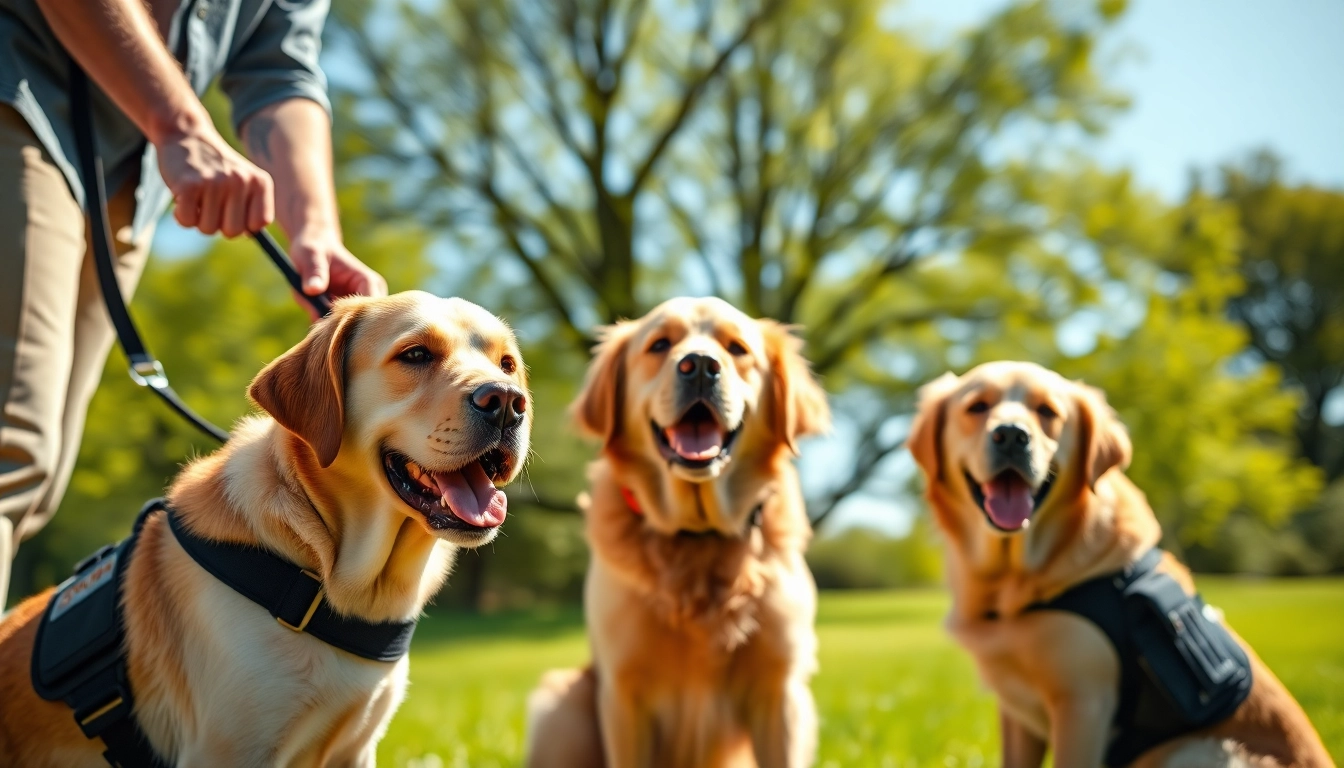Understanding PTSD and the Role of Service Dogs
What is PTSD?
Post-Traumatic Stress Disorder (PTSD) is a mental health condition that is triggered by experiencing or witnessing a traumatic event. Individuals affected may experience a range of symptoms, including flashbacks, nightmares, severe anxiety, and uncontrollable thoughts about the incident. PTSD is not just a disorder that affects veterans of war; it can impact anyone who has witnessed traumatic events such as natural disasters, serious accidents, or acts of violence. According to various mental health organizations, PTSD affects millions of people, and its symptoms can be debilitating, making daily functioning a struggle.
How PTSD impacts daily life
The repercussions of PTSD can infiltrate almost every aspect of a person’s life. Individuals may find it difficult to maintain relationships, hold down jobs, or socialize. Struggles with concentration and memory often lead to challenges in academic or work settings. Moreover, people suffering from PTSD can experience heightened emotional responses, leading to irritability and difficulty in managing stress. These issues can lead to isolation, creating a vicious cycle where the lack of support exacerbates the condition. Thus, finding effective coping mechanisms and support systems is crucial for recovery and daily functioning.
Overview of PTSD service dogs
PTSD service dogs are specially trained canines that provide support, assistance, and companionship to individuals suffering from PTSD. These dogs are trained to perform specific tasks that mitigate the symptoms of PTSD, ensuring that their owners can lead a more balanced and functional life. Tasks may include alerting the owner to anxiety attacks, encouraging them to step outside, or providing tactile stimulation to bring the person back to the present during a flashback. The bond formed between a PTSD service dog and their handler is profound and often transformative, allowing individuals to navigate everyday challenges more effectively. For those interested in exploring the healing potential of PTSD service dogs, understanding both their role and the specific needs of a handler is vital.
Benefits of PTSD Service Dogs for Individuals
Emotional support and companionship
One of the most significant benefits of having a PTSD service dog is the emotional support they offer. The companionship of a dog can alleviate feelings of loneliness and isolation that often accompany PTSD. Service dogs provide unconditional love and presence, which can be reassuring in stressful situations. Their ability to sense emotional unease allows them to provide comfort when their handler is at their most vulnerable, helping to foster a sense of safety and security.
Reducing anxiety and panic attacks
PTSD often results in heightened anxiety and panic attacks. Service dogs are trained to recognize the early signs of an anxiety attack and can take action to mitigate it. This may involve nudging, pawing, or leaning against the person, providing physical comfort that can disrupt spiraling thoughts. Additionally, the act of caring for a dog can also serve as a grounding technique, diverting the handler’s attention away from intrusive thoughts and redirecting it towards the needs of their canine companion.
Encouraging social interactions
For many individuals with PTSD, social situations can be especially daunting. The presence of a service dog can facilitate interactions with others, serving as a conversation starter and providing comfort in public settings. As handlers engage in activities with their service dogs, they are often encouraged to interact with other dog owners or therapy groups, fostering a sense of community that might otherwise feel unreachable. This social bridge can promote healing and a more active lifestyle.
Training and Certification for PTSD Service Dogs
Essential skills and tasks
Training is critical for a PTSD service dog to perform their role effectively. Essential skills often include recognizing anxiety and distress signals, performing deep pressure therapy by laying on or leaning against the handler, and providing a physical barrier in crowded settings to create a sense of safety. These tasks are designed to interrupt the cycle of panic or distress, allowing the handler to regain composure. Additionally, service dogs can be taught to retrieve medication, provide tactile stimulation, and guide individuals out of triggering environments.
Finding a qualified training program
Not all dogs are suited for service work, and choosing a suitable program is vital. Organizations specialized in training PTSD service dogs will assess the temperaments and abilities of dogs to ensure they can successfully complete training and provide the necessary support. It’s essential to find a program with a proven track record, experienced trainers, and positive reviews from past clients. The best training programs often offer extensive support, even after the placement of a service dog, ensuring both the handler and the dog continue to thrive in their partnership.
Understanding legal requirements
In the United States, laws such as the Americans with Disabilities Act (ADA) provide guidelines about the rights of individuals with service animals. While emotional support animals provide comfort, only dogs that have been trained to perform specific tasks for an individual with a disability qualify as service animals under the ADA. It’s essential for handlers to understand these legal frameworks to ensure that they can navigate public spaces confidently. Documentation from mental health professionals, while not mandatory, can be beneficial in advocacy scenarios.
Considerations for Obtaining a PTSD Service Dog
Assessing personal needs and lifestyle
Before obtaining a PTSD service dog, individuals must carefully consider their lifestyle and specific needs. Not everyone with PTSD will benefit from having a service dog. Assessing daily routines, living conditions, and the willingness to commit to the care of a dog are all crucial factors in this decision-making process. Those with an active lifestyle may find a service dog to be an excellent companion, while others might decide that an emotional support animal would meet their needs without the necessity of specialized training.
Costs and financial assistance options
The cost of obtaining a trained PTSD service dog can be substantial, often ranging from thousands of dollars to complete comprehensive training and support. However, many organizations offer financial assistance, grants, or fundraising resources to help offset these costs. It’s advisable for individuals to research various funding options and to understand the full scope of expenses involved, including veterinary care, food, and ongoing training or support, to ensure they are prepared for financial commitments.
Matching with the right service dog
Finding the right service dog is not solely about the dog’s training; it’s also about personality compatibility. Handlers should consider their preferences for a dog’s size, temperament, and energy level. Some may thrive with an active, energetic dog, while others might do better with a more relaxed and calm companion. Many organizations emphasize the matching process, allowing potential handlers to interact with dogs before making a final decision. This mutual selection can ensure a harmonious partnership that enhances healing.
Future of PTSD Service Dogs and Ongoing Support
Research and advancements in therapy
As the awareness of mental health issues continues to grow, research into the effectiveness of PTSD service dogs also advances. Ongoing studies are exploring the physiological and psychological benefits of service dogs, seeking ways to enhance training methodologies and broaden the understanding of how dogs can aid recovery. This research is crucial in solidifying the evidence-based practice of integrating service dogs into therapeutic environments, ultimately benefiting handlers and mental health professionals alike.
Community resources and support networks
Community support is vital for individuals with PTSD, and service dog programs often connect handlers to larger resources. These networks can provide workshops, peer support groups, and information about mental health resources tailored specifically for service dog owners. Collaboration between handlers and mental health professionals can enrich the support system, fostering a holistic approach to recovery and stability. Understanding community resources and establishing connections can lead to more enriching experiences for both the handler and their service dog.
Personal stories of recovery and success
Countless individuals have attributed their recovery and improved quality of life to the support of their PTSD service dogs. Personal success stories help to illuminate the transformative power of this partnership. These narratives often encompass a range of experiences—from individuals regaining independence to building relationships and finding joy in everyday activities. Celebrating these stories within the community can inspire others, emphasizing that recovery is possible, and highlight the essential role that service dogs play in navigating life beyond PTSD.



